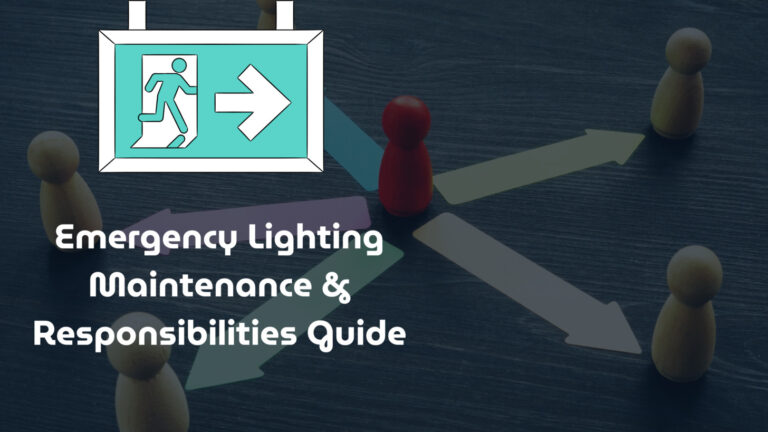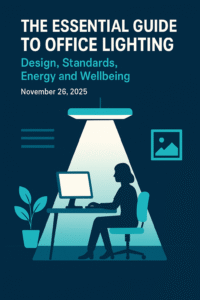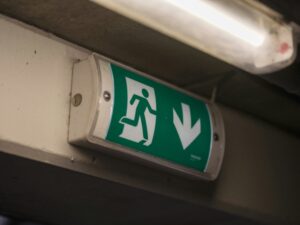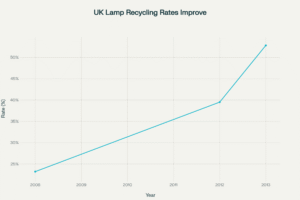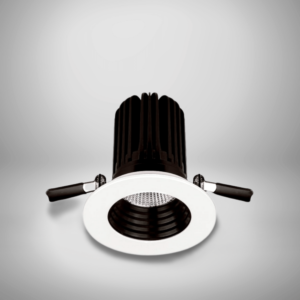According to a 2023 survey by the Fire Industry Association, nearly 40% of UK commercial buildings were found to have deficient emergency lighting systems during safety inspections. This widespread non-compliance represents a significant safety risk and potential liability for business owners across the country.
Emergency lighting isn’t merely a recommended safety feature—it’s a mandatory requirement under the Regulatory Reform (Fire Safety) Order 2005. For commercial establishments, properly functioning emergency lighting systems are essential for legal operation.
To maintain compliance with key standards like BS5266 and EN1838, businesses must conduct regular inspections and testing. These regulations ensure that emergency lighting provides sufficient illumination during power failures, creating safe evacuation routes and potentially saving lives during emergencies.
Our guide is designed to help the responsible person manage fire safety effectively. From installation to servicing, we cover the roles of maintenance and testing to ensure your system meets legal requirements. By following these steps, you can reduce risks and demonstrate due diligence in occupant safety.
Stay with us as we explore the responsibilities and benefits of maintaining a compliant emergency lighting system. Let’s ensure your business is prepared for any situation.
Introduction to Emergency Lighting Systems
Understanding the importance of emergency lighting systems is crucial for any building’s safety. These systems are designed to provide illumination during power failures, ensuring safe evacuation routes and reducing risks during emergencies. They are not just a precaution but a statutory requirement under UK fire safety regulations.
What Are Emergency Lights and Their Purpose?
Emergency lights are specialised fixtures that activate during power outages. Their primary purpose is to illuminate exit routes, stairways, and critical areas, guiding occupants to safety. These systems are essential in high-risk environments such as hospitals, schools, and commercial buildings.
According to BS5266, emergency lighting must provide adequate intensity to ensure visibility. This includes illuminating escape routes, fire-fighting equipment, and alarm call points. Proper planning and installation are key to meeting these standards.
The Role of Emergency Lighting in Fire Safety
In the event of a fire, visibility can mean the difference between life and death. Emergency lighting ensures that escape routes remain visible, even in smoke-filled environments. This is particularly important in large or complex buildings where occupants may be unfamiliar with the layout.
Regular inspection and testing are vital to ensure these systems function correctly. Monthly checks and annual tests are mandatory to comply with fire safety regulations. These routines help identify faults early, ensuring the system is always ready for use.
By adhering to these requirements, building owners can demonstrate their commitment to occupant safety. Compliance not only reduces risks but also protects against legal liabilities.
Regulatory Framework and Legal Responsibilities
Navigating the legal landscape of fire safety can be complex, especially when it comes to emergency systems. In the UK, compliance with BS5266 and EN1838 is mandatory for all commercial buildings. These standards ensure that your lighting system meets the necessary requirements for safety and functionality.
UK Regulations, Standards, and Codes
The Regulatory Reform (Fire Safety) Order 2005 sets the foundation for fire safety compliance. It mandates that all buildings must have a reliable lighting system in place. This includes regular tests to ensure the system operates correctly during power outages.
BS5266 specifies the minimum lux levels for escape routes and open areas. For example, escape routes must have at least 1 lux at floor level, while open areas require 0.5 lux. These standards are designed to prevent panic and ensure safe evacuation.
Legal and Risk Assessment Responsibilities
Senior directors hold statutory responsibilities for ensuring compliance. This includes conducting formal risk assessments by competent persons. These assessments identify potential hazards and ensure the lighting system is fit for purpose.
Testing routines are also critical. Daily checks are required for central power supply indicators, while monthly tests verify that all lights function correctly. Annual tests ensure the system can sustain illumination for the required duration.
| Test Type | Frequency | Purpose |
|---|---|---|
| Daily | Every day | Check central power supply indicators |
| Monthly | Every month | Verify all lights function correctly |
| Annual | Once a year | Ensure full-duration illumination |
Proper installation and commissioning are equally important. These processes ensure the system meets all legislative and safety standards. By adhering to these guidelines, building owners can demonstrate their commitment to occupant safety.
Emergency Lighting Maintenance Best Practices
Ensuring the reliability of safety systems is a cornerstone of building security. Regular upkeep not only enhances compliance but also safeguards occupants during critical moments. By adhering to structured maintenance routines, you can minimise risk and ensure uninterrupted power when it matters most.

Monthly Checks and Testing Procedures
Monthly checks are essential to verify the functionality of your safety systems. These tests ensure that all components operate correctly during a power outage. Key steps include inspecting individual units, confirming illumination levels, and documenting results for compliance purposes.
Proactive assessment during these checks helps identify potential issues early. This reduces the likelihood of system failure and ensures continuous security. Regular testing also aligns with risk assessment protocols, ensuring your building meets all safety standards.
Annual and Six-Monthly Inspections for Compliance
Annual inspections involve a thorough assessment of the entire system. This includes a full discharge test to confirm the system can sustain illumination for the required duration. These tests are critical for maintaining compliance with safety regulations.
Six-monthly inspections focus on partial discharge tests. These ensure the system’s batteries remain functional and ready for use. Regular inspections not only enhance security but also reduce the risk of unexpected failure during emergencies.
Documenting all tests and inspections is vital. It provides a clear record of compliance and demonstrates due diligence in maintaining safety standards. By following these best practices, you can ensure your building remains secure and compliant at all times.
Initial Installation and Troubleshooting Guidance
Proper installation and troubleshooting are key to ensuring safety systems function flawlessly. Whether you’re commissioning new luminaires or addressing faults, following best practices is essential for compliance and reliability.
Commissioning New Safety Systems
When installing new luminaires, initial checks are crucial. Ensure the main power supply is stable and all connections are secure. Allow a recommended waiting period before conducting battery discharge tests to ensure accurate results.
Testing under simulated power failure conditions is vital. This verifies that the system provides adequate illumination for escape routes and exit points. Always document these tests for compliance purposes.
Common Faults and Effective Troubleshooting Tips
Common issues include problems with the main power supply or improper battery charging. If luminaires fail to illuminate, check the connections and ensure the battery is functioning correctly.
For issues with exit illumination or escape route visibility, inspect the design and placement of the units. Ensure they meet safety standards and provide sufficient coverage.
If problems persist, contact a qualified electrician. They can diagnose and resolve complex issues, ensuring your system remains reliable. Regular testing and proactive troubleshooting are essential for maintaining safety and compliance.
Conclusion
Maintaining safety systems is a critical responsibility for all businesses. Regular inspections and tests ensure these systems function flawlessly during critical moments. Statutory regulations and risk assessments play a vital role in keeping your operation compliant and secure.
Proper installation and professional servicing enhance system reliability. It’s essential to ensure all staff are familiar with safety procedures and the operation of these systems. This awareness can make a significant difference during emergencies.
Thorough upkeep guarantees full coverage and seamless integration with fire alarm systems. By prioritising these measures, businesses can protect occupants and meet legal requirements.
We urge organisations to ensure emergency lighting is in place and fully compliant. Regular testing and professional support are key to maintaining safety standards. Let’s work together to keep your premises secure and prepared.
FAQ
What is the purpose of emergency lights in a building?
Emergency lights ensure safe evacuation during power failures or emergencies. They illuminate escape routes, exits, and critical areas, helping occupants navigate safely.
What UK regulations govern emergency lighting systems?
In the UK, systems must comply with BS 5266 and EN 1838 standards. These ensure proper design, installation, and performance for fire safety and compliance.
How often should we test our emergency lighting?
Monthly functional tests and annual full-duration checks are required. This ensures the system operates correctly during emergencies and meets legal standards.
What are the key responsibilities for maintaining these systems?
We must conduct regular inspections, keep records, and address faults promptly. This ensures compliance with regulations and minimises risks during emergencies.
When should we upgrade our emergency lighting system?
Upgrades are needed if the system fails inspections, becomes outdated, or if building layouts change. Consulting a qualified technician ensures optimal performance.
What are common faults in emergency lighting systems?
Common issues include battery failure, damaged wiring, or faulty bulbs. Regular testing helps identify and resolve these problems quickly.
Why is risk assessment important for emergency lighting?
Risk assessments identify hazards and ensure adequate coverage. They help us design systems that meet safety standards and protect occupants effectively.
How do we commission a new emergency lighting system?
Commissioning involves testing all components, verifying compliance, and documenting the process. This ensures the system is ready for use and meets legal requirements.
